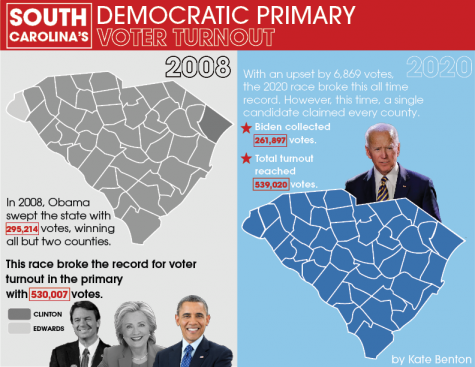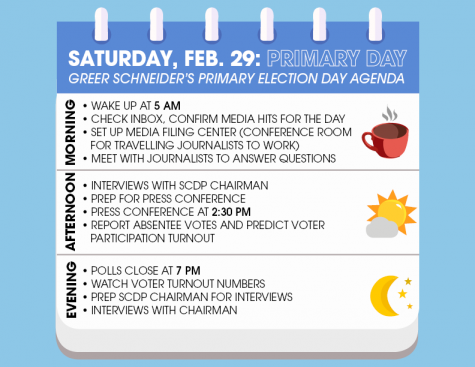Manual graduate Greer Schneider evaluates South Carolina’s Democratic Primary
March 6, 2020

Despite Obama’s record-breaking result in 2008, Joe Biden exceeded it. He won the majority of votes from every county. Voter turnout was a record high.
Last Saturday, South Carolina, the fourth and final early voting state, held its Democratic Presidential Preference Primary.
The race’s remaining candidates—with the exception of Michael Bloomberg, who did not enter the early voting ballots—battled it out in the last contest before March 3, Super Tuesday, in which 14 more states would vote in the Democratic Presidential Primaries.
Between Joe Biden, Bernie Sanders, Tom Steyer, Pete Buttigieg and Elizabeth Warren, Biden ran away with his victory in the state, gathering a whopping 48.7% of the votes.
No other candidate came within 20 points of Biden’s lead, the only one closest being Sanders, who trailed behind with 19.8%.
The 2020 South Carolina Primary reached a voting turnout milestone, breaking its all time record of total votes.
The previous record stood in 2008, when Barack Obama ran for his first term.
The South Carolina Democratic Party (SCDP) Communications Director and Manual graduate Greer Schneider analyzed these polling results with little surprise.
“He really understands South Carolinians and can communicate well with people that are in the state and can communicate on par with their values and beliefs. There was a period of time when all the candidates really stopped kind of coming to South Carolina and campaigning here for a bit because Joe Biden had such a strong lead,” Schneider said.
The candidate’s presence in the state has been rooted deep within the ground since the 1980s. He’s campaigned four times, vacationed on the coast and given the eulogies of two South Carolinian U.S. Senators, Fritz Hollings and Strom Thurmond.
“Many people here in the state claim that they know Joe Biden. But really, Joe Biden knows us,” Schneider said.
What does this mean for future Democratic elections?
According to Schneider, South Carolina reflects the Democratic Party across the nation because of its more diverse demographic.
In 2016, 61% of people who voted in South Carolina in the South Carolina Democratic Presidential Primary were African American. This year, that number was 55%.
This is widely different to the majority white Iowa and New Hampshire, two other early voting states.
“South Carolina is really known for being a great teller of how those candidates are going to do with the rest of the Democratic Party,” Schneider said.
Scheider believes that South Carolina’s results serve as a precursor to the rest of the nation’s polls.
“We can see that it’s a make or break state for campaigns you’ve already seen,” Schneider said, in reference to three other candidates ending their campaigns following the race.
“States that have been super red for a long time increased their turnout by almost 80%, which tells us there’s been some parts of the state that have been written off as republican territory for way too long. There are plenty of moderates and independents who are really starting to reconsider their party affiliation after the presidency of Donald Trump,” Schneider said.

A year before Trump even began his presidency, in 2015, Schneider was a senior at Manual.
As a graduate of J+C, she was the Editor-in-Chief of The Crimson Yearbook.
Four years later, Schneider completed her college education and began work for the Communications department in the SCDP.
Now, Schneider gets a behind-the-scenes perspective as the intermediary between Democratic candidates of every kind and voters.
“For the past couple weeks, it’s been very busy, which has been good, but really, we’re helping campaigns get in the best situation that they can be in to get out and connect with their voters. We share some of the data that we have on our side with those campaigns, so that they can reach Democratic voters. We have hosted events with each of the candidates in order to get our voters to meet the candidates and hear what they have to say face to face,” Schneider said.
Watching the turnout numbers on the night of the primary, Schneider felt hope as lights flashed across the screen.

“We knew we would surpass the 2008 benchmark,” Schneider said. “That’s extremely exciting because that means that the Democrats in South Carolina are positioned well to elect more democrats up and down the ballot next November, especially in races that we thought wouldn’t. We’ve seen lots of polls that show that that race can be closer than people anticipated.”










